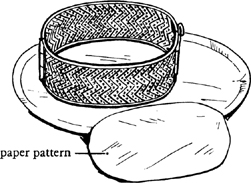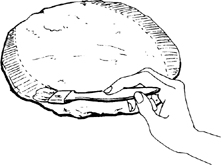Mastering the Art of French Cooking, Volume 2 (140 page)
Read Mastering the Art of French Cooking, Volume 2 Online
Authors: Julia Child

FORMING AND BAKING PÂTÉ EN CROÛTE IN A HINGED PÂTÉ MOLD
1)
Lining the mold with dough
Your first step is to line the bottom and sides of the mold with an even ⅜ inch layer of dough. An ingenious professional method is to form ¾ of the dough into a pouch, the bottom and sides of which fit neatly against the mold with a minimum of wrinkles while the open top falls around the outside leaving the mold open for filling. In French this is a
calotte,
a skull cap. (The following illustrations are for an oval mold; adapt the same system for rectangular and round molds.)
A hinged 6- to 8-cup
pâté
mold
A piece of heavy paper to serve as a pattern
Sheets of fresh pork fat ⅛ inch thick, enough to
line bottom, sides, and top of mold
Using
pâté
mold as a guide,
cut a pattern out of the paper to fit the opening of the mold.
Cut 2 pieces of pork fat, using pattern, and set aside; these will line bottom and top of
pâté
later. Reserve pattern for dough cover, later.
Chilled
pâté à croustades
dough made with 1 lb. of flour
A pastry brush and cup of cold water
Place ¾ of the chilled dough on a lightly floured marble or board and roll into a circle about 1 inch thick and 2 inches larger in diameter than the long side of the mold—dough must be very thick at this point so that when you are through rolling and forming it you will still have a ⅜-inch layer lining the mold.
Paint a 1-inch strip down each side, right and left, with water.
As the first step in making the pouch shape, dough is to be folded in half and corners are to be bent down as follows. Except at the 2 sides, sprinkle circle of dough liberally with flour to prevent sticking when folded in half.
Bring top down to bottom, making a semicircle with its curved side facing you. Gently press two sides, right and left, together to seal them, then pull the two corners (right and left at top of fold) down toward you as illustrated. |
|
| Starting with open side facing you, and making several passes with your pin, roll dough away from you to deepen pouch, so that when it is spread into the mold you will have an overhang of 2 inches: |
Be very careful here that you roll the dough evenly and that the final combined thickness of top and bottom layers is no less than ¾ inch; when the dough is thinner you risk breakage and leakage problems later on. (If by any chance you muff this on your first try, briefly knead dough into a ball, chill an hour or more to relax it, and start over again.)
2 to 3 Tb lard or shortening
A baking sheet with raised edges (to catch cooking juices)
Scissors
Grease inside of mold and baking sheet, and set mold on sheet. Fold dough lightly in half lengthwise and center in mold. Unfold and ease it gently into place by lifting sides of dough, being careful always that you do not stretch the dough and make it thinner at any point. Clip off a gob of extra dough and use it as a tampon, rather than your fingers, to press dough against pastry sheet and sides of mold.
Leaving a 1½- to 2-inch overhang, trim off excess dough with scissors. |
|






